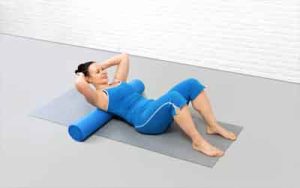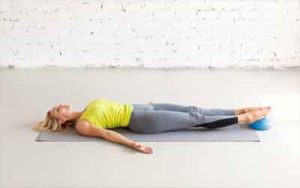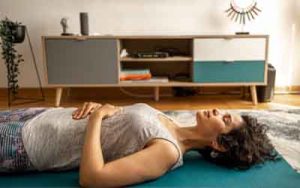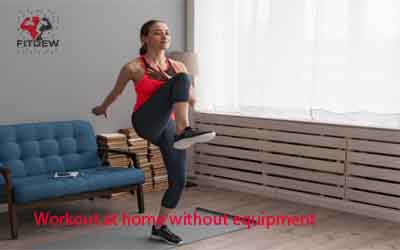Constipation cause pain for the individual experiencing it. There are some exercises that can help relieve it if you experience it.
This content is about exercises to relieve constipation and other things that will help you get relieved when you experience it. Read till the end to get all the details.

Overview of Exercises to Relieve Constipation
Before we talk about the exercises that will help you get relief from constipation, let’s know what Constipation is all about.
What is Constipation?
Constipation is when someone experiences difficulty while emptying the large bowel. Someone who encounters this may find it difficult to stool, pain, bloating, nausea, and other symptoms. The stool may be hard and dry.
Issues like the stool slowly passing through the colon can result in constipation. The slower the movement of food through the digestive tract, the more water will be absorbed by the colon, which results in the feces becoming harder.
Main symptoms of constipation
- Experiencing difficulty in stooling
- Straining when stooling
- Stooling lesser than usual
- Lumpy, hard, or dry stool
- Pain as well as cramping in the abdomen
- Feeling bloated
- Nausea
- Loss of appetite
Complications that can arise as a result of constipation
Even though constipation is not life-threatening, it makes one uncomfortable. It only becomes an issue if it is a symptom of a serious health condition like colorectal cancer, or when it causes more harm.
Here are some of the complications
- Rectal bleeding after straining
- Anal fissure (this is a small tear around the anus)
- Symptomatic hemorrhoids (piles), which are swollen, inflamed blood vessels in the anus
- Fecal impaction, which happens when dried stool stagnates and collects in the rectum and anus, and this results in a possible mechanical obstruction.
- A reduced quality of life as well as depression
Complications resulting from constipation can be prevented if medical advice is gotten about the issue.
Causes of Constipation
Let’s look at the causes of constipation
- Absence of fiber in the diet: People who eat high-fiber foods are unlikely to encounter constipation because fiber helps in regular bowel movements, mostly when combined with proper hydration.
Foods high in fiber
Fruits
Vegetables
Whole grains
Nuts
Lentils, chickpeas, and other legumes
Foods low in fiber
High-fat foods like cheese, meat, and eggs
Highly processed foods like white bread
Fast foods, chips, as well as other premade foods
- Physical inactivity: Another cause of constipation is physical inactivity. When you don’t engage so well in physical activities, it may result in constipation.
People who spend many days or weeks in bed or sitting in a chair have a high chance of encountering constipation.
- Some medications: Certain medications can as well enhance the chances of encountering constipation.
Here are some of the medications that can cause constipation
Opioid pain relief drugs like codeine (present with acetaminophen in Tylenol #3), oxycodone (OxyContin), and hydromorphone (Dilaudid).
Tricyclic antidepressants like amitriptyline (Elavil) and imipramine (Tofranil).
Certain anticonvulsants like phenytoin (Dilantin) and carbamazepine (Tegretol).
Calcium channel blockers: These lower blood pressure and some types lower heart rate. They include diltiazem (Cardizem) and nifedipine (Procardia).
Antacids that contain aluminum like Amphojel and Basaljel.
Antacids containing calcium like Tums.
Diuretics: These remove excess fluid from the body. They include hydrochlorothiazide (Hydrodiuril) and furosemide (Lasix).
Iron supplements: These medications are prescribed by doctors for the treatment of iron deficiency anemia.
- Irritable bowel syndrome: People who encounter functional intestinal difficulties like irritable bowel syndrome (IBS), have a high chance of experiencing constipation than people without the condition.
Here are things a person with IBS may experience
Abdominal pain
Bloating
Distension
Changes in the frequency or consistency of stools
With IBS, there may be fluctuation in constipation over time. When constipation is not present, there may be loose stools with diarrhea.
- Aging: The older someone gets the more likely it is to encounter constipation. The main reason for this is still not clear. It may be a result of the fact that food takes longer to pass through the digestive tract as people age.
Medical conditions, medications, as well as low intake of fiber or water may be other factors that lead to constipation with age.
- Changes in routine: Another cause of constipation is a change in routine. For example, if someone travels the usual routine changes and this can affect the digestive system.
When you eat your meals, go to bed, and use the bathroom at different times from the usual time you do, it could increase the chances of experiencing constipation.
- Too much use of laxatives: For the fact that some people worry about not using the bathroom as often as they ought to, they take laxatives in order to resolve the issue. Even though laxatives aid with bowel movements, regular use of some laxatives makes the body get used to their action.
It can make the person keep on using laxatives even when it is no longer needed. The person may require more doses of laxatives to get the same effects.
That is to say, the more a person is dependent on laxatives, the higher the chances of encountering constipation when they stop using them.
Too much use of laxatives can lead to the following
Dehydration
An electrolyte imbalance
Internal organ damage
Some of the complications can be life-threatening. So, to be on the safer side, people should talk to a healthcare professional before they begin to use laxatives.
- Not using the bathroom when necessary: Any time someone ignores the urge to have a bowel movement, the urge may go away gradually until they no longer feel the need to go.
The longer they delay using the toilet, the drier and harder the stool will become and this increases the chances of fecal impaction.
- Not drinking enough water: Regular drinking of enough water can assist in reducing the chances of experiencing constipation. Some other fluids that are suitable for you to take include naturally sweetened fruit or vegetable juices and clear soups.
Note that certain liquids can enhance the chances of being dehydrated and also make constipation worse for some people. For example, people prone to constipation should reduce their intake of caffeinated sodas, coffee, and alcohol.
- Colorectal problems: Certain health conditions that affect the colon can hinder as well as restrict the passage of stool which can result in constipation.
Here are examples of such conditions
Cancerous tumors
A hernia
Scar tissue
Diverticulitis
Colorectal stricture, which is an abnormal narrowing of the colon or rectum
Inflammatory bowel disease (IBD)
Some other medical conditions that can cause constipation are
- Neurological conditions: Multiple sclerosis, Parkinson’s disease, stroke, spinal cord injuries, and chronic intestinal pseudo-obstruction can lead to constipation.
- Conditions that involve hormonal function, electrolytes, or renal function: These include uremia, diabetes, hypercalcemia, and hypothyroidism.
- Intestinal blockage: This can occur if a tumor blocks or squeezes part of the digestive system.
- Conditions that affect the digestive system: Constipation can occur with celiac disease, IBD, and other inflammatory conditions.
- Cancer treatment: Chemotherapy and opioid pain relief medications, can also trigger constipation.
Treatment for Constipation
- Constipation normally resolves itself without the need for prescription treatment. Most times, lifestyle changes like exercising more, eating high-fiber food, as well as drinking enough water can assist in treating constipation.
- Allowing time for defecation, without stress or interruption can also assist in treating it. People should also know they are not supposed to ignore the urge to have a bowel movement.
- Laxatives can improve symptoms in the short term, but they should be used with care and when necessary.
The Food and Drug Administration (FDA) encourages people to check with their doctor before using them and to follow the instructions on the label with care.
If constipation is persistent, people should see a doctor. They may need stronger medication and the doctor may also test for any underlying conditions.
Certain laxatives are available over the counter, while others are available with a prescription.
The use of laxatives should only be considered when lifestyle changes do not work for the treatment.
Here are Some Laxatives and stool softeners that can assist in easing constipation
- Fiber supplements: This is also known as bulk-forming laxatives, and may be the safest option. Fibercon is one example. People should take these with enough water.
- Stimulants: These make the muscles in the intestines contract rhythmically. Senokot is one example.
- Lubricants: These assist the stool in moving smoothly through the colon. One example is mineral oil (Fleet).
- Stool softeners: These moisten the stool. Examples of stool softeners include Colace and Surfak.
- Osmotics: These draw water into the colon to hydrate the stool and ease movement. Saline laxatives are a type of osmotic.
- Neuromuscular agents: These include opioid antagonists and 5-HT4 agonists. They work at specific receptors to control movement through the gut.
Other treatment options
If laxatives do not work, a doctor may need to remove the impacted stool manually or surgically.
- A doctor may suggest an abdominal imaging study such as a CT scan, MRI scan, or X-ray to see if there is a blockage as a result of an underlying disease process in the gut. The suggestion for this will come in if it does not respond to treatment or if there are other symptoms.
- A person may need specific prescription medications or surgery to resolve it. It depends on the results of the tests and the person’s response to medical or surgical therapy; they may also require additional treatment.
Here are natural remedies to treat constipation
- Increasing intake of fiber: Increasing your intake of fibers like fresh fruits and vegetables, as well as fortified cereals. When you add high-fiber foods to your meals, it assists in softening stools as well as making them easier to pass.
- Drinking enough water: Drinking enough water will assist in the hydration of your body and prevent constipation.
- Exercise regularly: Exercising regularly will assist in making bodily processes more regular, which includes the passing of stools.
- Establish a routine: Ensure you have a usual place and time of day to visit the bathroom without having to force yourself to stool.
- Avoid holding in stools: Always respond to the body’s urge to pass stool because this assists in the prevention of constipation.
- Elevating the feet: Some people find passing stool easier during a bowel movement if they place their feet on a low platform, such as a step, with their knees above hip level.
Alternative remedies to constipation
Other therapies that can resolve constipation are acupuncture, massage, herbal remedies, and moxibustion, which involves stimulating acupuncture points with the herb mugwort.
Because of the complexity of the use of herbal remedies, ensure you speak to a doctor before trying anything new, as they can have adverse effects.
Exercises to Relieve Constipation
Here are 4 exercises you can engage in to get relief from constipation
- Cardio: Cardio exercises that get your blood pumping are the simplest form of physical activity that can assist you in preventing constipation.

Whether it is running, swimming, cycling, or dancing, a cardio workout will enhance your breathing, boost your heart rate, as well as stimulate your bowels.
Going for a 30-minute walk can do wonders for your digestive system. Cardio is one of the best ways to relieve stress, which can be a major risk factor if you encounter chronic constipation.
The Centers for Disease Control and Prevention recommends 150 minutes of moderate-intensity aerobic exercise each week for adults. You can try out 30 minutes a day exercise at least five times a week if that will be possible for you to do.
- Yoga: Practicing yoga is another great way to help get your bowels moving as well as relieve constipation.
Some yoga poses work to massage the digestive tract and assist in moving stool through your intestines, specifically those that involve sustained twisting of your torso or crunching of your stomach muscles.
Check out these three easy poses that can ease constipation

Wind-relieving pose: This pose assists in easing the discomfort of bloating and gas, as well as stimulating your bowels and improving overall digestion.
How to carry out a Wind-relieving pose
- Lie flat on your back with your legs fully extended in front of you.
- Slowly raise your right knee up to your chest and hold it in place with your arms for a count of 20 breaths.
- Release your knee and let your leg extend fully in front of you again.
- Carry out the same action with your left leg for another 20 breaths.
- Repeat the process once more, this time holding both legs to your chest.
Seated twist: This is a great pose if you are new to yoga. It is very easy to do.
How to carry out the Seated twist
- Sit comfortably on the floor with your legs fully extended in front of you.
- Bring your left knee up so that your foot rests flat on the ground close to your buttocks.
- Twist your core by placing your right elbow on the opposite side of your left knee and looking over your left shoulder.
- Hold this pose for five deep breaths, and then release.
- Repeat the same action on the opposite side of your body.
Supine twist: This is another twisting pose that assists in massaging your digestive tract and stimulating blood flow to your stomach muscles.
How to carry out a Supine twist
- Lie flat on your back and bring both of your knees up to your chest.
- Stretch your left leg out straight.
- Keeping your shoulders pressed against the floor, move your right knee across your body to the left and look toward your right.
- Hold this position for 20 breaths and then release.
- Repeat the same process on the opposite side of your body.
- Pelvic floor exercises: Your pelvic floor is the layer of muscles at the bottom of your pelvis that includes your bladder and bowel. By working these muscles out, you can build up their strength and aid them to push stool through your colon more easily.

How to carry out Pelvic floor exercises
- Sit comfortably on the floor with your knees shoulder-width apart.
- Imagine that you are trying to stop yourself from passing gas, and squeeze the muscles around your anus as tightly as possible.
- Hold for five seconds, and then release and relax for a count of 10.
- Repeat this process five times.
- Do the same thing, only at half strength.
- Repeat this process five times.
- Finally, squeeze and release the muscles tightly and quickly as many times as you can before you get too tired to continue.
- Deep breathing exercises: Engaging in this exercise is another way you can assist in enhancing your digestive functioning and relieve any stress that can result in constipation. The exercises take a few minutes and can be carried out virtually anywhere. The exercise is called the 4-7-8 technique.

How to carry out the Deep breathing exercises
- Sit in a chair with your back straight and your hands resting comfortably in your lap.
- Breathe out through your mouth, exhaling completely.
- Close your lips and inhale through your nose for a count of four seconds.
- Hold your breath for a count of seven seconds.
- Exhale completely through your mouth for a count of eight seconds.
- Repeat these steps three more times for a total of four complete
Conclusion
Constipation is something that can happen as a result of dietary habits, medical conditions, and a range of other factors.
Remember to consult with your doctor before starting out any new exercise regimen to avoid straining your body. If you are experiencing any health issues that were not present before trying out a new physical activity, stop trying out the method and contact your doctor as soon as possible.
If you experience any symptoms or discomfort of constipation, discuss it with your doctor. Make sure you eat the right meals to avoid constipation.
Editor’s pick
7 Easy Exercises for a Flat Stomach and Small Waist
10 Best Gym Exercises for Stress Relief and Relaxation (A must read for everyone)



